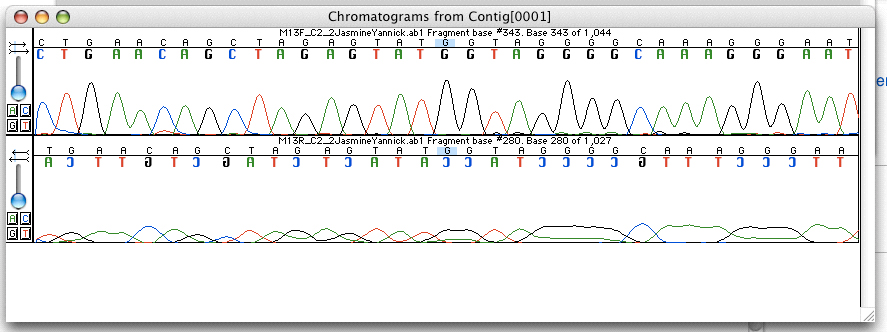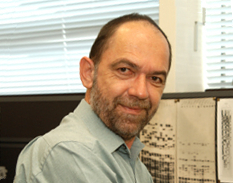|
Electropherogram
An electropherogram, or electrophoregram, can also be referred to as an EPG or e-gram. It is a record or chart produced when electrophoresis is used in an analytical technique, primarily in the fields of forensic biology, molecular biology and biochemistry. The method utilizes data points that correspond with a specific time and fluorescence intensity at various wavelengths of light to represent a DNA profile. In the field of genetics, an electropherogram is a plot of DNA fragment sizes, typically used for genotyping such as DNA sequencing. The data is plotted with time, shown via base pairs (bps), on the x-axis and fluorescence intensity on the y-axis. Such plots are often achieved using an instrument such as an automated DNA sequencer paired with capillary electrophoresis (CE). Such electropherograms may be used to determine DNA sequence genotypes, or genotypes that are based on the length of specific DNA fragments or number of short tandem repeats (STR) at a specific locus b ... [...More Info...] [...Related Items...] OR: [Wikipedia] [Google] [Baidu] |
DNA Profiling
DNA profiling (also called DNA fingerprinting) is the process of determining an individual's DNA characteristics. DNA analysis intended to identify a species, rather than an individual, is called DNA barcoding. DNA profiling is a forensic technique in criminal investigations, comparing criminal suspects' profiles to DNA evidence so as to assess the likelihood of their involvement in the crime. It is also used in paternity testing, to establish immigration eligibility, and in genealogical and medical research. DNA profiling has also been used in the study of animal and plant populations in the fields of zoology, botany, and agriculture. Background Starting in the 1980s, scientific advances allowed the use of DNA as a material for the identification of an individual. The first patent covering the direct use of DNA variation for forensicsUS5593832A was filed by Jeffrey Glassberg in 1983, based upon work he had done while at Rockefeller University in the United States in 1981. ... [...More Info...] [...Related Items...] OR: [Wikipedia] [Google] [Baidu] |
Gel Electrophoresis Of Nucleic Acids
Nucleic acid electrophoresis is an analytical technique used to separate DNA or RNA fragments by size and reactivity. Nucleic acid molecules which are to be analyzed are set upon a viscous medium, the gel, where an electric field induces the nucleic acids (which are negatively charged due to their sugar-phosphate backbone) to migrate toward the anode (which is positively charged because this is an electrolytic rather than galvanic cell). The separation of these fragments is accomplished by exploiting the mobilities with which different sized molecules are able to pass through the gel. Longer molecules migrate more slowly because they experience more resistance within the gel. Because the size of the molecule affects its mobility, smaller fragments end up nearer to the anode than longer ones in a given period. After some time, the voltage is removed and the fragmentation gradient is analyzed. For larger separations between similar sized fragments, either the voltage or run time ca ... [...More Info...] [...Related Items...] OR: [Wikipedia] [Google] [Baidu] |
Chromatogram
In chemical analysis, chromatography is a laboratory technique for the separation of a mixture into its components. The mixture is dissolved in a fluid solvent (gas or liquid) called the ''mobile phase'', which carries it through a system (a column, a capillary tube, a plate, or a sheet) on which a material called the ''stationary phase'' is fixed. Because the different constituents of the mixture tend to have different affinities for the stationary phase and are retained for different lengths of time depending on their interactions with its surface sites, the constituents travel at different apparent velocities in the mobile fluid, causing them to separate. The separation is based on the differential partitioning between the mobile and the stationary phases. Subtle differences in a compound's partition coefficient result in differential retention on the stationary phase and thus affect the separation. Chromatography may be preparative or analytical. The purpose of preparativ ... [...More Info...] [...Related Items...] OR: [Wikipedia] [Google] [Baidu] |
Genetic Genealogy
Genetic genealogy is the use of genealogical DNA tests, i.e., DNA profiling and DNA testing, in combination with traditional genealogical methods, to infer genetic relationships between individuals. This application of genetics came to be used by family historians in the 21st century, as DNA tests became affordable. The tests have been promoted by amateur groups, such as surname study groups or regional genealogical groups, as well as research projects such as the Genographic Project. As of 2019, about 30 million people had been tested. As the field developed, the aims of practitioners broadened, with many seeking knowledge of their ancestry beyond the recent centuries, for which traditional pedigrees can be constructed. History The investigation of surnames in genetics can be said to go back to George Darwin, a son of Charles Darwin and Charles' first cousin Emma Darwin. In 1875, George Darwin used surnames to estimate the frequency of first-cousin marriages and calculated t ... [...More Info...] [...Related Items...] OR: [Wikipedia] [Google] [Baidu] |
Biometrics
Biometrics are body measurements and calculations related to human characteristics. Biometric authentication (or realistic authentication) is used in computer science as a form of identification and access control. It is also used to identify individuals in groups that are under surveillance. Biometric identifiers are the distinctive, measurable characteristics used to label and describe individuals. Biometric identifiers are often categorized as physiological characteristics which are related to the shape of the body. Examples include, but are not limited to fingerprint, palm veins, face recognition, DNA, palm print, hand geometry, iris recognition, retina, odor/scent, voice, shape of ears and gait. Behavioral characteristics are related to the pattern of behavior of a person, including but not limited to mouse movement, typing rhythm, gait, signature, behavioral profiling, and credentials. Some researchers have coined the term behaviometrics to describe the latter class ... [...More Info...] [...Related Items...] OR: [Wikipedia] [Google] [Baidu] |
Applied Genetics
Genetic engineering, also called genetic modification or genetic manipulation, is the modification and manipulation of an organism's genes using technology. It is a set of Genetic engineering techniques, technologies used to change the genetic makeup of cells, including the transfer of genes within and across species boundaries to produce improved or novel organisms. New DNA is obtained by either isolating and copying the genetic material of interest using recombinant DNA methods or by Artificial gene synthesis, artificially synthesising the DNA. A Vector (molecular biology), construct is usually created and used to insert this DNA into the host organism. The first recombinant DNA molecule was made by Paul Berg in 1972 by combining DNA from the monkey virus SV40 with the Lambda phage, lambda virus. As well as inserting genes, the process can be used to remove, or "Gene knockout, knock out", genes. The new DNA can be inserted randomly, or Gene targeting, targeted to a specific ... [...More Info...] [...Related Items...] OR: [Wikipedia] [Google] [Baidu] |
Population Genetics
Population genetics is a subfield of genetics that deals with genetic differences within and between populations, and is a part of evolutionary biology. Studies in this branch of biology examine such phenomena as adaptation, speciation, and population structure. Population genetics was a vital ingredient in the emergence of the modern evolutionary synthesis. Its primary founders were Sewall Wright, J. B. S. Haldane and Ronald Fisher, who also laid the foundations for the related discipline of quantitative genetics. Traditionally a highly mathematical discipline, modern population genetics encompasses theoretical, laboratory, and field work. Population genetic models are used both for statistical inference from DNA sequence data and for proof/disproof of concept. What sets population genetics apart from newer, more phenotypic approaches to modelling evolution, such as evolutionary game theory and adaptive dynamics, is its emphasis on such genetic phenomena as dominance, epi ... [...More Info...] [...Related Items...] OR: [Wikipedia] [Google] [Baidu] |
Phylogenetics
In biology, phylogenetics (; from Greek language, Greek wikt:φυλή, φυλή/wikt:φῦλον, φῦλον [] "tribe, clan, race", and wikt:γενετικός, γενετικός [] "origin, source, birth") is the study of the evolutionary history and relationships among or within groups of organisms. These relationships are determined by Computational phylogenetics, phylogenetic inference methods that focus on observed heritable traits, such as DNA sequences, Protein, protein Amino acid, amino acid sequences, or Morphology (biology), morphology. The result of such an analysis is a phylogenetic tree—a diagram containing a hypothesis of relationships that reflects the evolutionary history of a group of organisms. The tips of a phylogenetic tree can be living taxa or fossils, and represent the "end" or the present time in an evolutionary lineage. A phylogenetic diagram can be rooted or unrooted. A rooted tree diagram indicates the hypothetical common ancestor of the tree. An un ... [...More Info...] [...Related Items...] OR: [Wikipedia] [Google] [Baidu] |
DNA Paternity Testing
DNA paternity testing is the use of DNA profiles to determine whether an individual is the biological parent of another individual. Paternity testing can be especially important when the rights and duties of the father are in issue and a child's paternity is in doubt. Tests can also determine the likelihood of someone being a biological grandparent. Though genetic testing is the most reliable standard, older methods also exist, including ABO blood group typing, analysis of various other proteins and enzymes, or using human leukocyte antigen antigens. The current techniques for paternity testing are using polymerase chain reaction (PCR) and restriction fragment length polymorphism (RFLP). Paternity testing can now also be performed while the woman is still pregnant from a blood draw. DNA testing is currently the most advanced and accurate technology to determine parentage. In a DNA paternity test, the result (called the 'probability of parentage) is 0% when the alleged parent ... [...More Info...] [...Related Items...] OR: [Wikipedia] [Google] [Baidu] |
Genealogical DNA Test
A genealogical DNA test is a DNA-based test used in genetic genealogy that looks at specific locations of a person's genome in order to find or verify ancestral genealogical relationships, or (with lower reliability) to estimate the ethnic mixture of an individual. Since different testing companies use different ethnic reference groups and different matching algorithms, ethnicity estimates for an individual vary between tests, sometimes dramatically. Three principal types of genealogical DNA tests are available, with each looking at a different part of the genome and being useful for different types of genealogical research: autosomal (atDNA), mitochondrial (mtDNA), and Y-DNA. Autosomal tests may result in a large number of DNA matches to both males and females who have also tested with the same company. Each match will typically show an estimated degree of relatedness, i.e., a close family match, 1st-2nd cousins, 3rd-4th cousins, etc. The furthest degree of relationship is u ... [...More Info...] [...Related Items...] OR: [Wikipedia] [Google] [Baidu] |
DNA Sequencer
A DNA sequencer is a scientific instrument used to automate the DNA sequencing process. Given a sample of DNA, a DNA sequencer is used to determine the order of the four bases: G (guanine), C (cytosine), A (adenine) and T (thymine). This is then reported as a text string, called a read. Some DNA sequencers can be also considered optical instruments as they analyze light signals originating from fluorochromes attached to nucleotides. The first automated DNA sequencer, invented by Lloyd M. Smith, was introduced by Applied Biosystems in 1987. It used the Sanger sequencing method, a technology which formed the basis of the "first generation" of DNA sequencers and enabled the completion of the human genome project in 2001. This first generation of DNA sequencers are essentially automated electrophoresis systems that detect the migration of labelled DNA fragments. Therefore, these sequencers can also be used in the genotyping of genetic markers where only the length of a DNA fragmen ... [...More Info...] [...Related Items...] OR: [Wikipedia] [Google] [Baidu] |







